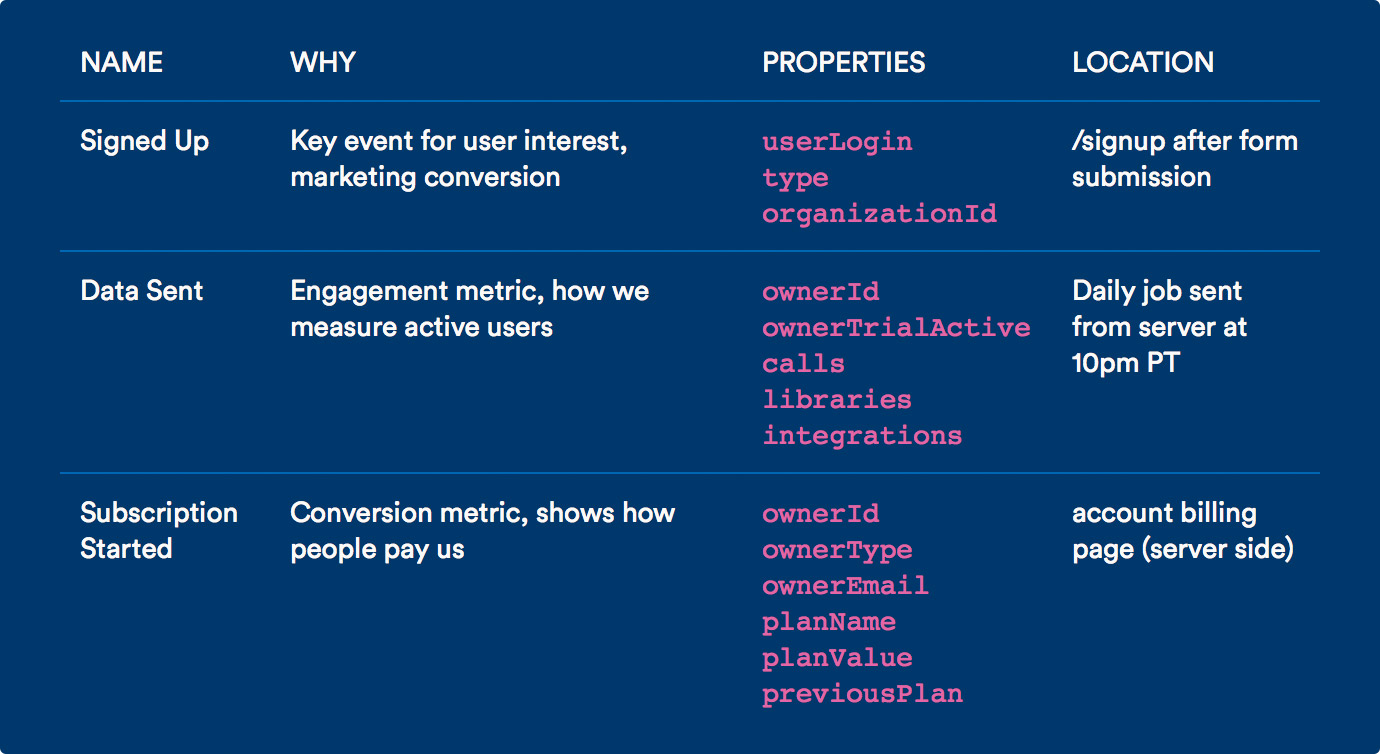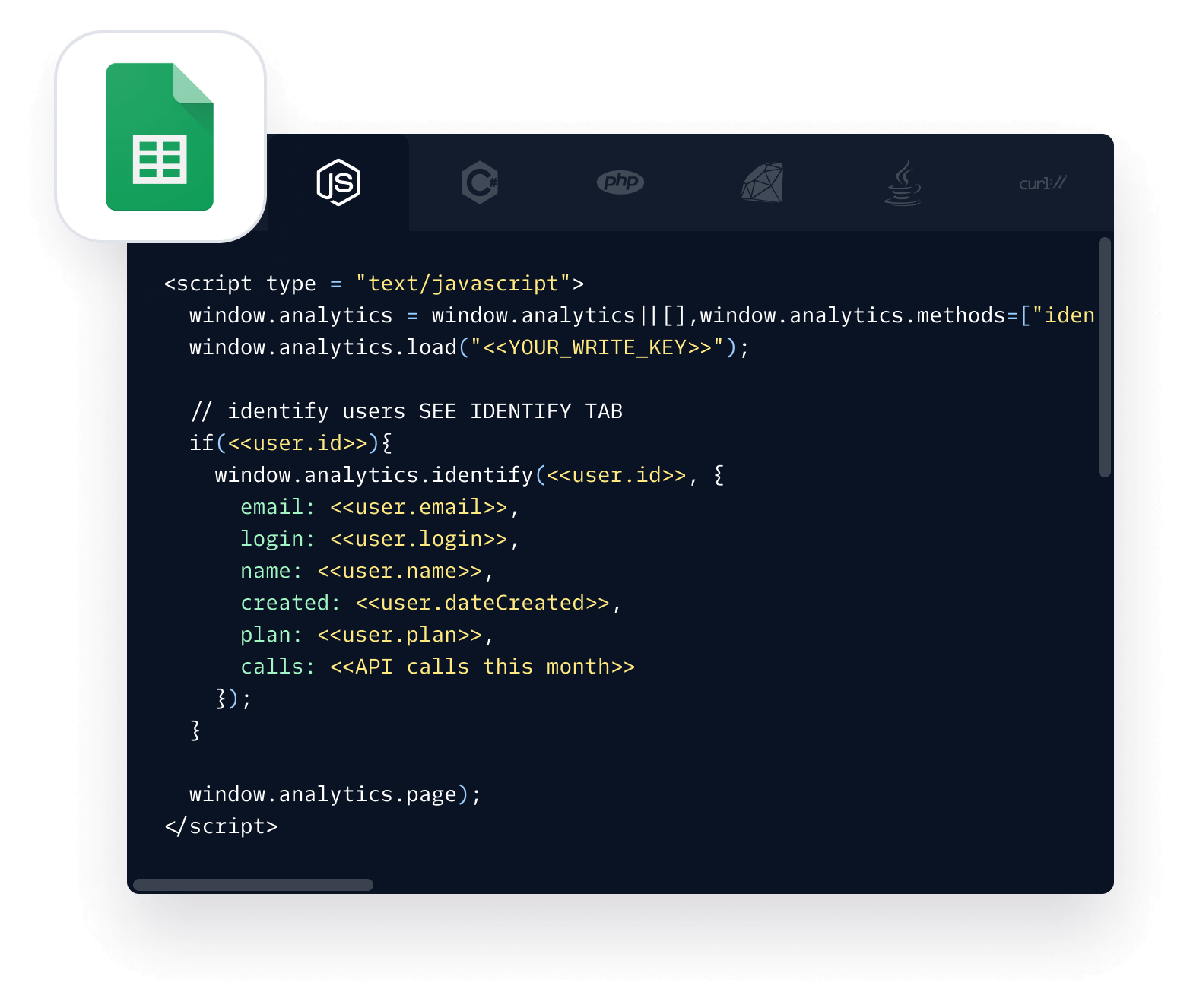A tracking plan is a document or spreadsheet used across an organization to standardize how it tracks data. Often serving as both a project management tool and a reference document, a tracking plan aligns multiple teams around one strategy for customer data collection.
Essentially, a tracking plan consists of a list of events (i.e., user actions) accompanied by a description for each event. These events are used to map the most important steps of the customer journey, from free trial sign-up to recurring subscription to churn.
This central list of events can grow and change alongside your company. All the while, it will provide a consistent road map for what data is important, where it’s being tracked, and why. In the end, your tracking plan can help you create an airtight process for scaling data collection across a growing company.
What is the role of a tracking plan?
Your tracking plan serves as the single source of truth across your organization for understanding what data you’re tracking, where you’re tracking that data, and why. A tracking plan usually has columns for each of these values, like this:

In this example, the “what” is the events and properties you track, which are logged in the NAME and PROPERTIES columns above. The “where” (logged under LOCATION) is the location and time at which the event is being tracked. Finally, the “why” (logged under WHY) is a short description of the business purpose that justifies tracking the event.
Not all tracking plans look exactly like this. They’re living documents that are built to suit the needs of the businesses they serve. You might use a different naming convention for event names and event properties, you might be more detailed in your “why” entries, or you might need to add new events. And as your business objectives evolve, so will the data you track. For instance, your naming convention might need to change as you add new features to your product.
No matter how it shapes up in the end or how it changes, the core purpose of a tracking plan remains the same: to coordinate your data collection in a central reference. Every team that touches customer data will be able to access and use this central reference, keeping them aligned with your current business objectives.
Meanwhile, every piece of your data infrastructure—including data warehouses like Snowflake, analytics tools like Mixpanel or Google Analytics, product intelligence tools like Amplitude, and much more—will speak the same “data language.” All these tools will be implemented with the tracking plan in mind, so they’ll all focus on the data you outline in your plan. This ensures your data is more consistent across the tech stack.
Over time, an airtight process will emerge for customer data tracking that’s consistent, compliant, and customized to your exact needs. All made possible with one document.
What are the benefits of a tracking plan?
A tracking plan is a collaborative document, taking input from every department that touches customer data. This process of collaboration forces your business to think of analytics as a team sport, where everyone agrees to play within a certain set of guidelines and work together toward a shared goal. Working together this way will help ensure your business utilizes higher-quality data, gains alignment across teams, and establishes a framework for consistent growth.
In the short term, the quality of your data will improve, and your teams will be more efficient, thanks to a codified process for tracking customer data.
-
Your data will be cleaner because every team is using the same process for collecting it.
-
Your data will be compliant with regulations because you’ve documented the what, why, where, and how of your customer data tracking.
-
The whole organization will gain alignment around one clearly documented and easy-to-understand plan for tracking data.
In the long term, a tracking plan becomes a living part of your company’s infrastructure and one of the primary drivers of growth.
-
Tracking plans are living documents that will provide a flexible framework for your customer data that grows and changes alongside your company.
-
For launches and update releases, a tracking plan will help you set metrics-driven goals that can help your teams build a better product.
A tracking plan is a long-term investment into the future of how your business collects data, the benefits of which are both immediate and long-lasting.
What events should I track?
The specific events you decide to track are unique to your business and depend on a lot of factors, like how your product is designed, who your audience is, your overall business goals, and more.
In short, you should track events that provide answers to questions you have about your customers, like who they are, how they behave, and what they want. To identify your questions, you need to decide on what exactly you want to learn—that is, what questions do you have that, if answered, will help your business grow?
Consider the question, “When do people who sign up for a free trial decide to purchase a full subscription?” In this case, you might start by tracking the events “Signed up” and “Subscription started” to hone in on that conversion rate.
Start broad then narrow in on opportunities for improvement. The first question you might ask could be, “What are the key steps to our customer journey?” Once you have your answer, you can move on to “Where is our conversion funnel inefficient?” Then, you can get really specific with questions like, “How does our new subscriber rate change if we change in-product navigation?”
In the early days at Segment, we started by tracking three simple events:
-
Signed up
-
Project data sent
-
Subscription started
These events provided answers to our questions around who was signing up, how many of them were active in our product, and when to make the choice to upgrade. Over the years, our tracking plan has grown and changed with us.

Ready to get started?
Fair warning: Creating a tracking plan is a lot of work, but it’s well worth it in the end. As we’ve outlined here, start by approaching analytics as a learning process. With this approach, your customer data collection will center around finding answers to important questions. To get started, check out the data tracking template we've included below.
Data Tracking Plan Template
A data tracking plan helps businesses clarify what events they’re tracking, how they’re tracking them, and why. Use this template to help create your own tracking plan.

You’re all set!
Thank you for downloading this content. We've also sent a copy to your inbox.
Here are a few additional resources to help get things rolling:

The State of Personalization 2023
Our annual look at how attitudes, preferences, and experiences with personalization have evolved over the past year.